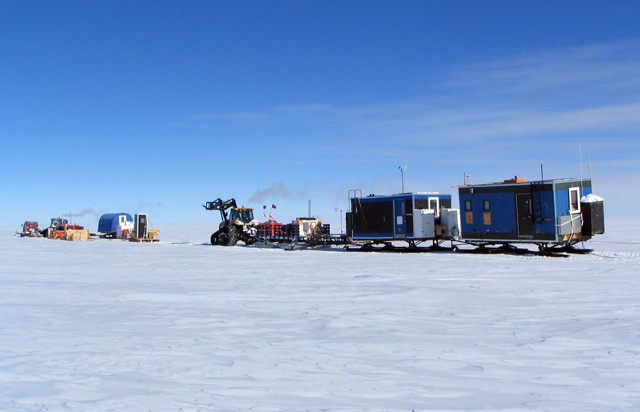Page 2/2 - Posted December 18, 2009
Feedback in the AntarcticThe warming would also likely affect the extent of sea ice cover around Antarctica, which the SCAR report says has actually increased 10 percent in extent since 1980 due to the stronger winds. Sea ice effectively doubles the size of Antarctica in the winter. Again, as the ozone hole closes and the winds decrease, sea ice would diminish, by as much as 30 percent by the end of the century, according to the report. Around the Antarctic Peninsula, where regional warming has been on a record-setting pace, sea ice has declined significantly. Work by U.S. Antarctic Program Mayewski noted that the disappearance of sea ice creates a positive feedback loop for warming. The white ice-covered ocean reflects the solar heat, while the darker ocean more readily absorbs the heat and warms up more, which causes more sea ice to disappear. That’s what is currently happening in the Arctic. “The same thing is going to happen around West Antarctica, and any coastal areas around Antarctica, so those regions will warm much more than the mean or average of 3 degrees centigrade,” he said. Bindschadler noted that it’s also deep, warmer ocean water coming up onto the continental shelf — where ice, bedrock and water meet — that’s driving the changes at the margins of the ice sheet. “That to me is a harbinger. Ice loss around the edges of the ice is what is becoming the norm now [more] than the exception,” he said. The SCAR report also discusses the effects of a warming Antarctic on the continent’s biology. For instance, sea ice is a key habitat where sea algae grow. Shrimplike krill graze on the algae, and larger critters like penguins and whale feed on the krill. A loss of sea ice, which is also a winter habitat for species like the Adélie penguin, could create a ripple effect throughout the food chain. “We see very clearly how the atmosphere is linked to the ocean, and how the ocean is linked to the ice sheet, and how the biological component is dependent on all three of those things,” Bindschadler said. “It’s a very tightly coupled system there.” Nate Biletnikoff, Environmental Engineering manager for Raytheon Polar Services “Understanding Antarctica’s environment and biologic communities in their present state and establishing a baseline in which to compare [future changes] is the primary component in accurately assessing human activities’ effects on the environment,” he said. More work aheadThe SCAR report uses only scientific papers that have appeared in peer-reviewed journals, many from U.S.-based researchers. The report represents an immense amount of NSF-funded research, said Mayewski, who led an international effort, the 21-nation International Trans Antarctic Scientific Expedition (ITASE) Both Mayewski and Bindschadler said there has been tremendous progress over the last several years in getting a better handle on processes that drive climate change in Antarctica. But both also cautioned that scientists are far from being able to create climate models that can accurately predict such as future ice loss and sea level change. “Science always lusts for more information,” Mayewski said. “Antarctica is an amazing treasure trove of information because it is the world’s largest repository of ice cores. It is such a dynamic system. It is so large; it is going to take us a long time to really understand the kind of details we need to bring to bear to understand how the Antarctic system operates.” Bindschadler said he believes the polar science community is at least 20 years away from understanding the system well enough to account for all the forces at work in the ocean-atmosphere-ice system. That’s partly because the places where scientists need to go for their work is still inaccessible or difficult to reach. “The specific places where we need to get the measurements are even the toughest of the tough locations,” said Bindschadler, whose fieldwork at Pine Island Glacier in 2011-12 will be the culmination of years of planning, with construction of a special field camp at the extreme limits of the USAP logistics chain to support the project. “We’re going to have to solve that,” he added. “We’re going to have to commit the resources to make those measurements, or we simply will not achieve the predictive skill people are calling for as our necessary objective.” NSF-funded support in this article: Paul Mayewski, University of Maine, Award No. 0837883 |



For USAP Participants |
For The Public |
For Researchers and EducatorsContact UsU.S. National Science FoundationOffice of Polar Programs Geosciences Directorate 2415 Eisenhower Avenue, Suite W7100 Alexandria, VA 22314 Sign up for the NSF Office of Polar Programs newsletter and events. Feedback Form |



